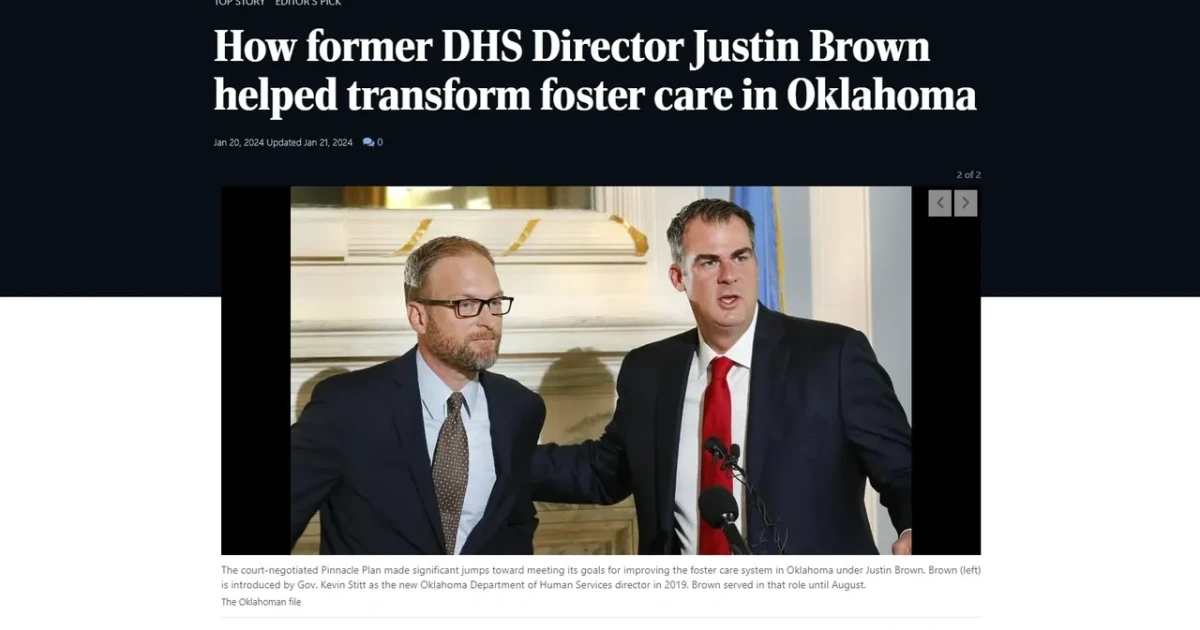How former DHS Director Justin Brown helped transform foster care

In the next two years, it’s possible that the Oklahoma Department of Human Services may ask a court to be released from a foster care improvement plan due to meeting all its goals. Credit for that transformation is going to former DHS Director Justin Brown.
The Pinnacle Plan came into being as a court-approved negotiated plan to make large shifts in how the state cared for abused and neglected children in its custody.
A federal class-action lawsuit filed in February 2008 alleged that harm was being done to foster children because the system had major flaws. Those included an over-reliance on emergency shelters, unmanageably high worker caseloads, dangerously low foster-care placement options and lack of coordination between policy and practices.
Tulsa attorney Fred Dorwart was among the co-counsel with New York-based Children’s Rights and attorney Paul DeMuro representing the children.
The resolution was unusual: an improvement plan created by the agency and a three-member panel of experts. That panel would provide progress reports to the court on a series of goals. The plan was approved in January 2012.
Implementation wasn’t easy, especially after the drawn-out adversarial litigation.
“It really changed when Justin Brown came in,” Dorwart said. “I remember having a meeting with him where he said, ‘We will get with this program and make this work.’ After that, instead of staff being defensive, they became open because they were encouraged to do so from the top.
“We had open and candid discussions about what they were doing that was right, wrong or needed to improve, rather than trying to hide or make excuses about what was going on. It became a cooperative process, and that was in year eight. It took us that long to get there.”
Under Brown’s leadership, the Pinnacle Plan progress reports showed consistent gains. In March last year, DHS was able to sunset 23 of 30 performance areas targeted for meeting goals. A September report stated that the agency is showing good faith and making sustained progress in the remaining areas.
Brown downplays his role, pointing to work done before his arrival, including caseloads being cut in half. The Legislature continued funding foster care reforms even through a decade of revenue failures.
“There was a team before me that did a lot of foundation work, and we had wonderful legislative partners,” Brown said.
He came into the job in June 2019 after 11 years operating senior housing companies. He had no prior experience in state government, though he interacted occasionally with the Aging Services Division of DHS. He took the job 60 days after a call from Gov. Kevin Stitt’s office about leading DHS.
“I spent all 60 days in a room at home thinking about what approach would be the sort of tone and message the next year would look like. The Pinnacle Plan was an example of how the agency was not a self-correcting organization,” he said. “It was not a system where staff felt safe to raise their hands to say there was a problem.”
One of Brown’s first moves was to hire Dr. Deborah Shropshire as the Child Welfare Division director. She is now serving as the governor’s secretary of health and human services and DHS executive director.
“She came in very focused on building relationships and collaboration,” Brown said.
Foster care is one slice of the Child Welfare Division. DHS also handles aging services, disability services, child care services and family services such as the distribution of the Supplemental Nutrition Assistance Program and low-income energy assistance program.
The agency serves about 1.5 million Oklahomans among its various services. Last year, it had a total budget of about $5.1 billion, with about $753 million of that from state appropriations.
“On the first day, I said to the whole team that no one has every answer to these problems. I’m not the person to come in with every single answer,” Brown said. “For me, it was all about building an intentional culture and strategy.”
Brown learned about the agency while also rebuilding the agency. That led to what he calls the “True North,” referring to its mission.
He breaks it down to four principles: First, DHS is a human-centered center built around the people it serves. Second, outcomes for success are driven by what it means for each person. Third, relationships outside the agency are critical. Fourth is the focus on a trauma-informed approach.
“That resonated with the team to see a sea change around collaboration and relationships. They started to feel the momentum behind the agency,” Brown said.
Updating technology became a priority, with some infrastructure decades old. He focused on laptops and mobile wireless connections to give workers, particularly in rural areas, flexibility to spend more time with clients. He shuttered smaller county offices to co-locate staff with other area social service groups.
The reorganization and update gave Oklahoma an edge when the pandemic hit; DHS workers were already equipped to shift to remote work.
“Our staff stayed on mission and met clients were they were. They performed with excellence,” Brown said.
The December 2020 Pinnacle Plan progress report commended DHS “for its thoughtful, proactive efforts, small and large” during the pandemic. It quoted from an August DHS report that, “above all else, (Child Welfare Services) takes a stubborn position against allowing a virus to disrupt the future trajectory of children and their families, and commits to tireless creativity in support of staff, children, families, and partners during this historic moment.”
The Pinnacle Plan focused on the narrow band of foster care, not on preventing child abuse or on child permanency placements. But the efforts in foster care may have affected the other areas. The number of foster children in Oklahoma hit a 20-year high in 2007 — the year before the lawsuit was filed — with 11,698 foster children. Last year saw a 20-year low of 6,502 children in foster care.
“With (Children’s Rights) in New York, I firmly believe these people are on the same side. We all want a family-building system that supports reunification and that healthy kids are growing up in proper environments. They want that; we want that. There may have been different approaches, but we can work on a foundation,” Brown said.
Brown resigned from DHS in August of last year to pursue other opportunities.
“From an emotional, personal perspective, I definitely grew,” he said. “Outside of being a father and husband, this has been the greatest thing I’ve ever done. I’m humbled by it and gave it everything I had.”
Brown hasn’t stepped away completely. He’s active nationally as a consultant to help other social service agencies become more effective.
“I am committed for the rest of my life in attempting to change the narrative around the people we serve, around the people who utilize safety net programs, around people who are in poverty,” he said.
“Oklahoma has come a long way. We are looked at among human service agencies as being among the most effective and innovative. But I see real transformation has to occur at the national level.”


